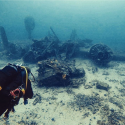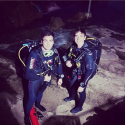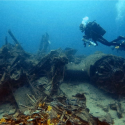As a part of the annual adventure training programme, 9 soldiers from 6 RIFLES and 1 outside instructor deployed on Ex TIGER ADRIATIC RIFLES to participate in a Sub-Aqua Diving expedition. This was conducted as an overseas deployment on the island of Vis (Croatia), spanning a 10 day period.
The aims of the deployment were to develop key military skills such as planning and communication in a challenging and hostile environment, also the developing and exercising our in-house instructors and SADS, and the training of the 6 RIFLES divers to enable future expeditions.
Day 1 – 29 Oct 18
All troops were to parade at 2100hrs at HMS Flying Fox (A Coy). An opening brief was given and the practical element of the CFAT assessment was conducted to avoid having to transport the Resus-Anne doll to Croatia. Diving kit was checked and issued to individuals, and baggage weight was checked. Once the pre-ex admin checks were complete we moved to LHR along the M4.
Day 2 – 30 Oct 18
Flying from LHR to Croatia, as our baggage would loaded, and further administration sorted we progressed through security, the flight boarded with no issue. Arriving at Munich airport, there was a comfortable margin to make the connecting flight to Split. Once in Split, it was discovered that one of the checked bags had not been put on the plane at Heathrow. This bag had been taken aside due to the pony cylinder for checking but had not been put back into the flight cargo. A minibus was waiting for us when we arrived to take us to the ferry terminal in Split. Once there, we were informed that the 1500 ferry was not running due to wind, and we would have to get the 1830 ferry. After a further 3 hours in Split, we boarded the ferry and made our way to Vis. Pre-arranged taxis collected us from the ferry and took us to the accommodation in Komiza. From here, CILOR was issued on a room-share basis. Dinner that evening was found at a local pizzeria as the supermarket was closed.
Day 3 – 31 Oct 18
After a few hours of rest, a briefing was held at 0830 in the communal area of the villa. The training for the day would consist of a shore-based shake-out dive to enable correct weighting and kit familiarisation, followed by a dive at a local site from a hard boat. The weather was ideal for shore diving, so a dive plan was worked out for the town harbour adjacent to the dive centre. The harbour had an average depth of 8-12m, though some pairs of divers found 13-15m depths. The second dive of the day was conducted on a local site with a patch of sea grass and an undersea drop-off which went to around 80m. As we were limited to dive no deeper than our morning dive, we all drifted along the wall of the drop off. There was an abundance of life on the side of the wall which was receiving nutrition from the current. Upon return to harbour, we were able to store our dive equipment on the boat which meant that we didn’t need to transport wet/heavy kit around. We held a de-brief at the dive centre and re-briefed for the following morning. After a journey to the local supermarket to stock up on food for the coming days, lectures were held in the common room for those who were training to be Sports Divers, Dive Leaders and Advanced Divers.
Day 4 – 01 Nov 18
The second day of diving was not as picturesque as the first. Rain had moved in overnight and the wind had picked up dramatically. The first dive site was planned to be the wreck of the Vassilios T. In May 1930, the ship ran aground and sank near the entrance to Komiza, and now lies on the seabed at 35-55m, though she is accessible to divers from 20m. She reported no loss of life and went down with a hold full of cargo and coal. The wind had caused a considerable current which needed to be considered by the divers. The wreck itself is almost intact and lies on its port side. The water had a visibility of around 20m, which caused the ship to emerge from the deep blue as we got closer to it. Diving in buddy pairs/threes, the deepest dive that morning was 35m with divers limited to 30m, 25m and 20m. The second dive of the day was a local reef which offered the chance to practice more skills with the sports diver and the advanced diver trainees. Following this, we moved our kit from the smaller diving boat onto the larger boat for the remainder of the expedition.
Day 5 – 02 Nov 18
The next morning saw the expedition wake up to drier skies but the same wind as the day before. The planned dive sites for the day were the wreck of the Tetti, and the same stretch of reef that we had dived on the first day. Having gotten to the Tetti, it was obvious that the wind and current was too high, and that we should attempt it later in the day when the wind was forecast to calm down. We instead went to the second dive site. The difficulties of navigating underwater revealed themselves when one pair of divers missed a point where they needed to change their bearing and began a swim out to sea. The dive boat was able to follow them and collected them at the end of the dive. Those divers that were able to find the caverns and underwater features on the wall were treated to an abundance of eels, soft corals and nudibranchs. Once all divers had surfaced and the mandated humiliation of the diver who got his buddy lost was over, the boat motored back to the wreck of the Teti. The wind had calmed considerably, and diving got swiftly under way.
The Teti was a cargo ship which sank in 1930 as the result of some poor seamanship by the crew. It lies at a depth of 10-34m and due to its position outside a cape, has become overgrown with marine corals and provides a home for several moray eels and barracuda. We initially went down to the stern to look at the helm, before coming up the wreck and surveying the boiler and open compartments. The boiler was occupied by a fairly large moray eel which made no attempt to hide from us. At the shallow end of the wreck there is a plateau of sea grass, which gave an ideal place for teaching and practicing skills.
The evening consisted of theory lessons.
Day 6 – 03 Nov 18
The weather was much calmer as we woke up for the 4th day of diving. The plan for the day was to travel to the other side of the island and dive the wreck of the “Tulsamerican”. In December 1944, an American heavy B-24 bomber was flying back from a mission over occupied Poland when she encountered a sortie of German fighter planes and was critically disabled. Crashing into the sea just off the coast Of Vis, the Tulsamerican sank beneath the waves and now sits between 40 and 55m. In order to dive the wreck and limit the risk of decompression illness, strict control measures were put in place on the 6 RIFLES divers. We were diving using a 27% mix of Nitrox which would reduce the rate of nitrogen loading whilst we were at depth in an effort to minimise the planned decompression that we would carry out on our ascent. For most of the divers on the exped, this was the first experience with live decompression which meant that the control measures had to be stringently enforced by the dive leaders. Descending on a shot line to 40m, the blue water gave way to the distinct shape of a large propeller. Getting closer to the wreck the 4 Pratt & Whitney engines gave way to the wings, fuselage and cockpit. It was evident that before crashing, the pilot had considered an emergency landing on the island as the landing gear had been partially deployed. We could only stay on the wreck for approximately 10 minutes before we knew that we would be hitting the agreed turn-around point of 110bar of remaining breathing gas. The ascent up to the surface was conducted with the mandatory decompression and safety stops before finally getting back onto the boat.
The second dive of the day was a much shallower dive at a site called the ‘Green Cavern’.
The average depth inside the cavern was 5m, though outside the entrance it dropped back to 25m with a decent reef system on the way down. The lack of light inside the cavern meant that it was a popular place for octopi to hunt during the day and for other marine species to take shelter. At the right time of day, the sun will align with a small opening in the roof of the cavern and a beam of sunlight will illuminate the green rocks inside. Due to the shallow depth of this site, the dive lasted over an hour. After returning to Komiza, we spent some time checking over our kit before preparing for a BBQ at the dive centre.
Day 7 – 04 Nov 18
Under the BrD, we were advised to plan a non-diving day as this reduces the risk of DCI.
WO2 Potten had arranged for a local battlefield tour of Komiza, with a trip to the WW2 airfield, a WW2 submarine pen and the dug in fortress which protected the south side of the island. Before the tour began, each member of the expedition was given the task of preparing a brief on a site that we would visit. Beginning with a 13th century fortified church, we looked at the evolution of the defences on Vis until the start of the Second World War and a brief about the Yugoslavic resistance against the Italian and German forces which had occupied much of what is now Croatia.
After returning to the accommodation in the middle of the afternoon, the theory assessments were performed for the Sports Diver and Dive Leader grades and an evening of dive planning and equipment care was conducted.
Day 8 – 05 Nov 18
The penultimate day of diving featured a return to the Vassilios T. The newly qualified sports divers would use the wreck as an opportunity to depth progress themselves to 30m and 35m. Approaching the wreck on a bearing, the gloom of the dark blue gave way to the hull and the divers once again explored the coal bunkers and lower decks of the ship that were not accessible earlier in the week.
The second dive of the day was around a large pinnacle that bottomed out at 25m. The pinnacle was abundant in life from crayfish, octopi, eels and fish. It was a relaxed and easy to manage dive, so the dives were led by the new Dive Leader trainees. Upon surfacing we headed back to the harbour and back to the accommodation where the remaining theory lessons were conducted.
Day 9 – 06 Nov 18
The final day of diving began at a local bay where the wreck of a tub boat lay at a promising depth of 35m. We had planned to dive to the maximum depth allowed by our qualifications and have a look around the tug, but upon descending it was quickly apparent that the dive brief had been incorrect and the tug actually lay around 40-45m. Dismayed by the finding, I made the decision to abandon the wreck dive and look around the wall of the bay instead.
The second dive was done over the wreck of the Tetti that we had visited before. Final skills were performed in the relatively calm current before the dive leaders guided the others around the wreck.
Finally, that evening gave the opportunity for a night dive in the Komiza harbour, not all divers participated as we had an early departure the following day. The pitch black of the sea meant that underwater navigation was only possible by following bearings and being mindful of the elapsed time. There was not a huge amount of life in the harbour so the divers ventured over to the base of some rocks to look for resting fish and octopi. After following their bearings back to the dive centre, a final debrief was held and kit was dried and packed for the following morning.
Day 10 – 07 Nov 18
The recovery phase of the expedition began with an early morning transfer back to the Vis ferryport. After arriving in Split, the exped caught the transfer to the accommodation and then began the post-exercise administration of cleaning all kit and setting it out to dry.
Day 11 – 08 Nov 18
The second day of recovery went very smoothly. The dried kit had been packed and all baggage was weighed before a minibus arrived to take us to the airport. We then checked in and boarded the flights back to LHR. Arriving back in the UK with all baggage, we picked up the return minibus and recovered back to A Coy where a final debrief was given and the expedition was dispersed.
Conclusion
Ex TIGER ADRIATIC RIFLES was a success. All participants on the exercise were able to develop their diving skills, with most gaining some form of further qualification. During the exercise, one soldier qualified as a BSAC Sports Diver, with three soldiers qualifying as Dive Leaders and two PADI – BSAC crossover courses. Others managed to make headway into their Advanced Diver qualification. During the planning phase, Rfn Gibson achieved a BSADS qualification and Rfn Darley achieved an instructor qualification. Rfn Darley was taken off the expedition at the last minute due to his civilian employment.



